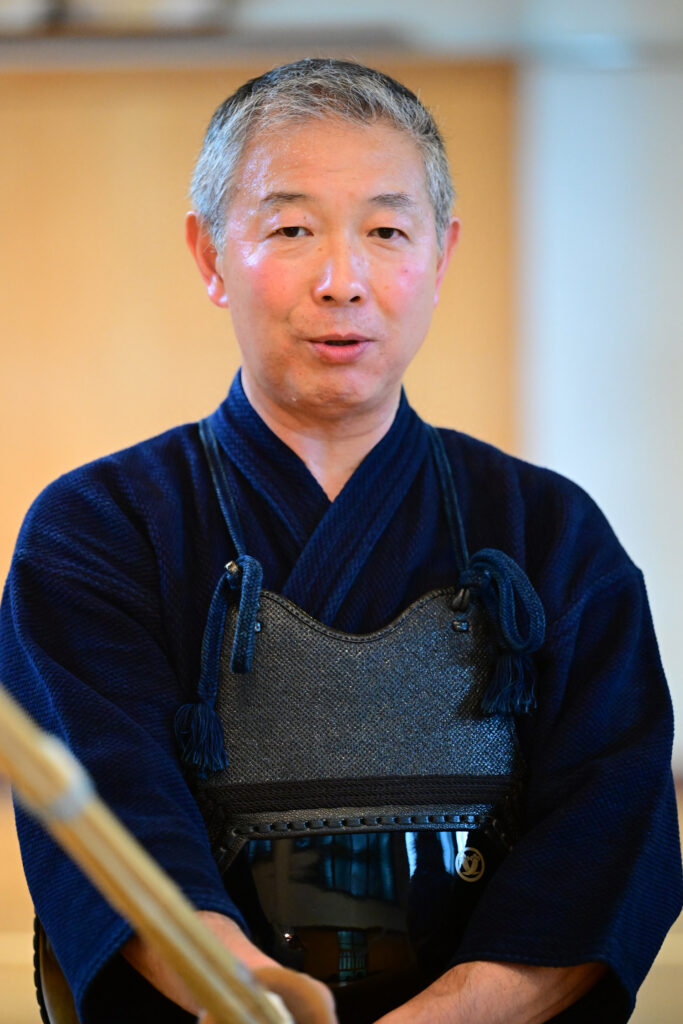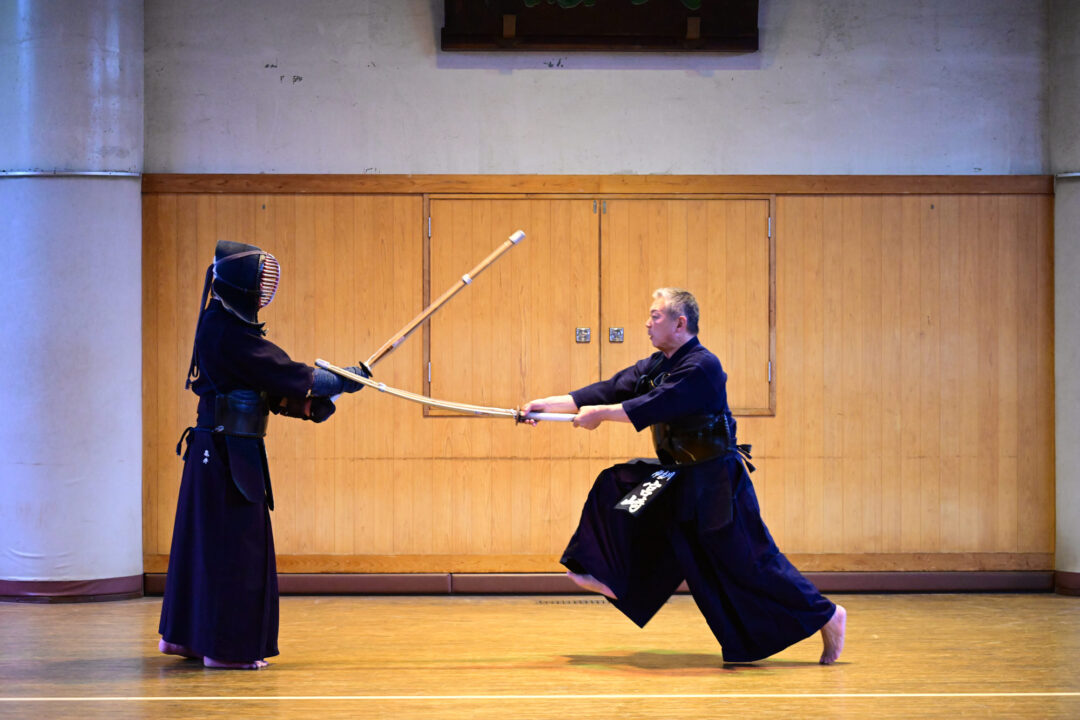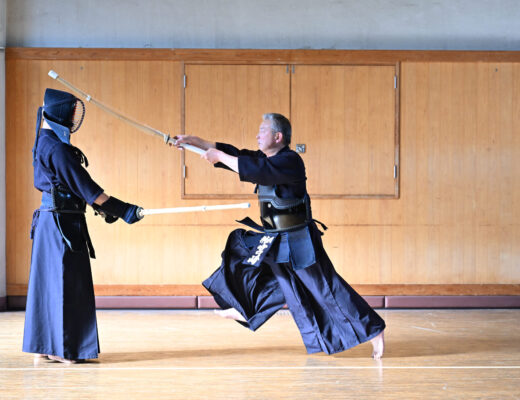2024.10 KENDOJIDAI
Photography: Nishiguchi Kunihiko
Composition: Tsuchiya Tomohiro
Translation: Sato Mariko, Pepijn Boomgaard
If your left foot isn’t positioned correctly from the moment you take your Kamae, your mindset won’t settle either. It is the left foot that governs the movements from initiating the attack, executing the strike, to achieving Zanshin. The left foot plays a crucial role in delivering sharp and precise strikes. Miyazaki Sensei explained the importance of the left foot in basic practice as well as its application in real matches.
Miyazaki Fumihiro, Kyoshi 8th Dan

When I was in elementary school, I began practicing Kendo at Genbukan Sakagami Dojo, where my older brother, Masahiro, trained. I was fortunate to learn the foundations and basics of Kendo there. The Dojo placed a strong emphasis on basics, and I remember faithfully adhering to its teachings. It was around the time I entered Tokai University Sagami High School that I started to become more aware of footwork. Under the strict guidance of Kida Seiichi Sensei, I thoroughly trained the basics. One teaching about footwork that sticks with me is “Keep moving, don’t stop and become static.” This led me to focus on using my feet and constantly shifting my body’s position.
As for my footwork, rather than moving side to side, I concentrated on making small, quick forward and backward movements, prioritizing balance so that I could strike at any moment. In this, the left foot’s readiness was crucial, serving as support, while the right foot was constantly in motion, adjusting the distance to the opponent. Naturally, when advancing forward, the left foot would follow, and when retreating to match the opponent’s movements, the left foot would move back accordingly.
When I became a Tokurenmember of the Kanagawa Prefectural Police, I also placed great emphasis on footwork. Since I have a smaller physique, I had to compensate for that by developing ways to control the Maai. My focus was on applying Seme fluidly and avoiding static footwork, making it difficult for my opponents to find an opening.
It was around the time when I was preparing for my 8th Dan examination that I started to focus on footwork that made it feel like I was firmly grounded. I became more conscious of using my footwork to maintain balance and prevent my body from collapsing.
The theme of this article is the left foot, but I have never particularly trained with a focus on where to apply force in the left foot. People often say to apply pressure to the base of the big toe or the metatarsal bones, and I believe I naturally use those areas. Coincidentally, I recently experienced persistent pain in that area, so I went to the hospital and had an X-ray taken, which revealed that I had osteoarthritis. This confirms that I have been using the base of my left foot when pushing off, though I had never been particularly conscious of it during regular practice.
However, I am careful to ensure that my left foot is always aligned with the direction I am moving and doesn’t turn outward. In other words, when stepping forward with the right foot during a strike, I make sure not to neglect pulling in the left foot, ensuring it follows closely and remains pointed straight in the direction of movement. I learned the importance of this left foot follow-through during a seminar at the Police Academy, where instructors from the Tokyo Metropolitan Police taught me. When performing continuous strikes or Oikomi they repeatedly emphasized the significance of pulling in the left foot.
Through this training, I realized that stabilizing the left foot contributed to my progression to the next stage in Kendo. I’ve seen practitioners whose left foot drags or becomes unengaged during strikes, which causes their overall balance to falter and makes it difficult to deliver sharp strikes. When the left foot moves quickly in tandem with the rest of the body, it ensures that the body doesn’t lag behind, resulting in sharp, crisp strikes. Therefore, it is essential to build proper left footwork through repeated basic training.
Kobayashi Hideo Sensei, who taught me at the Kanagawa Prefectural Police, used to say about the positioning of the left hand, “The left hand is the heart. If you move it recklessly from its proper position in Kamae, it reflects a disturbance in your heart.” I feel the same applies to the left foot. If my left foot is not properly positioned to maintain my balance in Kamae, my mindset will not be stable either. The left foot governs every movement, from Seme to striking and even to Zanshin. If your reactions are delayed, it means your left foot is not prepared quickly enough. Mastering the use of the left foot, tailored to your own body type, based on the fundamentals, is essential for improving in Kendo.
What I want you to focus on in this process is the coordination of the entire body. Even if you think you are using your left foot correctly, if there is a flaw in another part of your body, your overall movement will not be correct. When your body moves to strike, if your hands, feet, and hips are not in harmony, your movement will feel awkward. To master a specific aspect while keeping the whole body in mind requires a significant amount of time and repeated practice. Consider it part of building the foundation of your Kendo, and continue to refine it even as your skill level advances.
Additionally, without strengthening the muscles in your left leg, you won’t be able to generate sharp footwork. As we age, muscle strength inevitably declines, so it’s important to consciously focus on this in your training.
The Left Foot as the Axis for Overall Balance
The rest of this article is only available for Kendo Jidai International subscribers!



